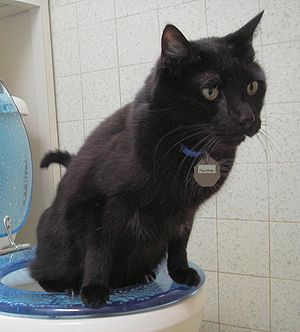I ordered the Lax-eze spray for two of my cats that have problems with bowel movements from time to time.
One of my cats has IBD and the spray does exactly what it says. I spray three times in his mouth, then later if no bowel movement. Then, I put some Lax-eze in his canned food and before evening ends he has had a painless bowel movement.
My other cat all I have to do is give him three sprays and within the hour he is having a normal bowel movements!
Excellent product, I highly recommend to any pet owner who has an animal with either occasional or frequent elimination problems…Saves money from not having to take your pet to the vet for an enema and keeps your pet happy and stress free.
How to Naturally Treat Feline Hairballs and Constipation
Why not be a panda?
Testimonial Tuesday: Nuroplex Edition
I am pleased with the product (Nuroplex) I found here as it has helped one of my dogs whom has epilepsy no end – In the past 6 months he has had just three minor fits. Before I gave him Nuroplex he was having an average of 54 fits over 4 days per month. Thank you.
Recognizing Dog Constipation Symptoms
The potential for constipation, difficulty defecating, increases as canines age. The digestive and elimination systems slow down and become less efficient with age, so older dogs tend to have more frequent problems with voiding and defecating.
The first signs of dog constipation may include reduced activity, eating less or avoiding food and whining for no apparent reason. Failure to expel waste is uncomfortable and moving around compounds the discomfort; your canine may not engage in playtime or perk up for the morning walk in an effort to move less.
Other symptoms to watch for include:
- Straining to produce a bowel movement without eliminating a stool. You may notice a small amount of watery liquid during these efforts. This mucus discharge from the anus may resemble diarrhea.
- Producing dry, chalky clumps of fecal matter.
- Scooting.
- Redness, swelling or tenderness in and around the anal area.
- Abdominal tenderness and/or bloating.
- An abnormal gait. Your pet may appear to be “walking on tiptoes” with an arched back and stiff back legs. Some pet owners report their pets “shuffle” instead of walking with a normal stride.
More Serious Concerns Normal elimination is a sign that your canine is healthy. If you notice changes in your pet’s stool that include changes in color, excessive mucus or blood, contact your vet immediately to rule out serious health conditions and digestive tract disorders.
Treatment Encourage your pet to drink plenty of water, especially during warmer weather to avoid dehydration. Mineral oil added to food works as a stool softener; making elimination more productive and less painful. Follow directions to administer the proper dosage based on your pet’s age, weight and normal activity level.
Adding more fiber to your dog’s diet and increasing daily exercise will help regulate your pet’s elimination. It is normal for your dog to have occasional irregularity; however, if symptoms persist consult with your veterinarian.
Testimonial Tuesday: VetSelect Kidney and Bladder Treatment
My dog Missey who is going on 14yrs, was diagnosed with having bladder stones. I was told by my vet that there was nothing on the market I could give her to correct the problem outside of an operation to clean her out, that would have cost me over $3000.00 plus, and no guarantee of the outcome or that the bladder stones wouldn’t come back. Due to missey’s age I did not find acceptable, and decided to have her put down, when I came across the KIDNEY/BLADDER meds from ALLERGIC PET online. Being a little skeptical about how well this would work I figured at this point it didn’t really matter and it was cheaper than an operation, so I went for it. My dog Missey has made a 180% turn around after her first treatment. She’s acting like her old self again and no negative side affects that I can see. All I can say is THANK YOU SO VERY MUCH for saving my dog, she’d be gone now if it wasn’t for your product. THANKS AGAIN
Natural Allergy Treatment for Cats

English: Young male tabby cat, Portugal. Français : Jeune chat tigré mâle, au Portugal. Русский: Молодой кот. (Photo credit: Wikipedia)
Cats and humans can suffer from some of the same allergies. These days, more and more owners are turning to natural treatments for allergies in their cats.
An allergy is the result of an overreaction by the feline immune system to a substance eaten, inhaled or simply encountered in the environment. For an allergy to occur, the cat must be exposed to the culprit at least two times.
There are two kinds of reactions. Hives and itching are the usual symptoms of immediate exposure. Delayed reactions can cause itching days after exposure.
Common Cat Allergies
Four types of allergies are the most common:
Inhalants.Cats are often allergic to foreign particles in the air. The most common offenders are trees, weeds, grass, mold, mildew and dust mites. In most climates, pollen allergies occur only in the spring and summer. Typical signs include head and neck itching, a rash on the neck and back, skin eruptions and hair loss from overzealous licking or grooming
Fleas.The presence of fleas causes an immediate immune response. However, the cat might still be itching days after flea removal.
Foods.Food allergies are usually acquired. The biggest causes are products with beef, pork, chicken or turkey. Possible symptoms include itching, digestive disturbances and respiratory issues. Sometimes the eyes and/or ears are involved.
Contact reactions.They usually cause minor skin irritation and scratching. Causes are substances found in an object the cat uses, such as a bed or a flea collar.
Traditional Treatments
The type of traditional treatment appropriate depends on the kind of allergy the cat has and the duration of exposure. The most common include:
- Steroids
- Desensitization immunizations
- Medicated shampoos
- Immunosuppressant drugs
Steroids and immunosuppressants can cause significant side effects because they reprogram the immune system. Desensitization is expensive, takes up to two years and is successful in just half the cats treated.
Natural Treatments
A natural cat allergy treatmentis often less costly, more convenient and likely to produce fewer side effects. Many owners have had good results with:
- Avoidance of the offending substance
- Hypoallergenic foods with meats like duck or venison
- Omega-3 fatty acids
- Biotin
Before using any treatment, remember to always get your veterinarian’s recommendations.
Dog Allergies and Scratching
Regardless of the type of allergy your dog has, it may lead to scratching. Scratching causes its own host of problems, including skin infections and hot spots. Skin infections can manifest in several different ways, and often get worse if left untreated.
Skin Infections
Skin infections may be cause by fungal growth, bacterial growth and inflammation from itching. Allergies cause itching, which in turn may cause inflammation, which causes more itching – the result is open sores where more bacteria and fungi will grow.
Depending on the type of skin infection your dog has, it may require anti-parasitic agents, anti-fungicides or antibiotics to keep it from spreading and to clear it up. You can also try to treat your dog with herbal remedies.
Symptoms of Skin Infections
Check the warm, moist environments on your dog – its mouth, lips and groin – for signs of skin infection. You should also check toes, elbows, belly and your dog’s tail for signs of infection, as they are pressure points that bruise or rupture easily and allow the introduction of infection below the skin’s surface.
The infection may look similar to the inflammation caused by a flea infestation and allergies. Superficial skin infections – infections on the “outer” skin often show up as redness, inflammation, small bumps and some hair loss – should be treated before they migrate to “deep skin” infections. These deeper skin infections present with foul odor, puss and lumps that look bloody on top of the skin.
Treatment
Diagnosis and treatment is nothing to fool with, but you must determine the underlying cause of the skin infection. If your dog has allergies, once the skin infection has been treated, it will come back with a vengeance if the underlying cause has not been treated. Allergies can cause a vicious circle: They can cause skin infections, which you clear up, but because the allergies have not been contained, the skin infection reappears, usually worse.
You can treat your dog with an herbal remedy such as Skin-eze, but be sure to see your veterinarian about the proper medication required to eradicate the skin infection. You will have to treat your dog’s allergies for its life if you want to try to avoid skin infections.
If your dog seems to constantly get infections, be sure to use a shampoo created for allergy dogs, and dry it off completely after a bath or swimming. The moisture can contribute to the growth of bacteria on your dog’s skin.
Testimonial Tuesday: “All products have worked for my specific needs.”
“I was very happy with my 1st purchase of tablets,shampoo & spray for my old Cavalier King Charles Spaniel Charlotte, who constantly scratched and knibbled at her self (she was under treatment by a vet,) but I found these products to work much better. Then I purchased,ear drops for my other Cavie Nelson, and my final purchase was more shampoo for my Labrador grandog Ted Brown who although a young dog suffers very bad body odor. All products have worked for my specific needs. I will continue to use them and recommend them to others. Thank all the people at Allergic Pet for a great product. And as long as I can have them delivered to Australia I will buy them.”
Another satisfied customer! Keep the reviews coming. ![]()
Top 5 at-home Remedies for Treating Dog Allergies
Dogs can develop allergies, just like humans can. Symptoms can be similar as well. However, you do not want to treat your pet’s allergies the same way that you treat yours. Over the counter allergy medicines can be very dangerous and even deadly to your dog. Here are the top 5 at-home remedies that can work for your dog.
- Oatmeal – Add one cup of oatmeal to a tub of warm water. Pour water over your dog’s coat, rubbing in circular motion to work the oatmeal water down to their skin. Allow to sit for 10 minutes and rinse your dog with warm water.
- Apple cider vinegar- Simply put the apple cider vinegar in a spray bottle, gently pull back the fur and spray directly onto the irritated skin.
- Avoid pollen – The best relief is avoiding it as much as possible. However, they will be exposed to some pollen outdoors. When your dog comes in from outside, wipe their face and paws with a damp cloth to wipe off any pollen on their fur.
- Avoid dust – It can irritate allergies in dogs. Vacuuming often and emptying the bag frequently can help, as well as using a dust cloth on surfaces where dust can gather. A good HEPA air filter system can help remove dust also.
- Change out food – If a food allergy is suspected, try a different brand. Making your dog’s food at home is an option many pet owners are turning to recently to ensure what their dogs are eating.
Finding the solution that works for your dog may take some time, but identifying the cause and treatment that works for your pet can bring them relief from the irritating symptoms of allergies.







